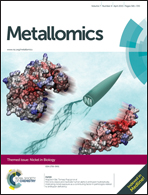SlyD-dependent nickel delivery limits maturation of [NiFe]-hydrogenases in late-stationary phase Escherichia coli cells
Abstract
Fermentatively growing Escherichia coli cells have three active [NiFe]-hydrogenases (Hyd), two of which, Hyd-1 and Hyd-2, contribute to H2 oxidation while Hyd-3 couples formate oxidation to H2 evolution. Biosynthesis of all Hyd involves the insertion of a Fe(CN)2CO group and a subsequent insertion of nickel ions through the HypA/HybF, HypB and SlyD proteins. With high nickel concentrations the presence of none of these proteins is required, but under normal growth conditions and during late stationary growth SlyD is important for hydrogenase activities. The slyD mutation reduced H2 production during exponential phase growth by about 50%. Assaying stationary phase grown cells for the coupling of Hyd activity to the respiratory chain or formate-dependent H2 evolution showed that SlyD is essential for both H2 evolution and H2 oxidation. Although introduction of plasmid-coded slyD resulted in an overall decrease of Hyd-2 polypeptides in slyD and hypA slyD mutants, processing and dye-reducing activity of the Hyd-2 enzyme was nevertheless restored. Similarly, introduction of the slyD plasmid restored only some H2 evolution in the slyD mutant while Hyd-3 polypeptides and dye-reducing activity were fully restored. Taken together, these results indicate an essential role for SlyD in the generation of the fully cofactor-equipped hydrogenase large subunits in the stationary phase where the level of each Hyd enzyme is finely tuned by SlyD for optimal enzyme activity.
![Graphical abstract: SlyD-dependent nickel delivery limits maturation of [NiFe]-hydrogenases in late-stationary phase Escherichia coli cells](/en/Image/Get?imageInfo.ImageType=GA&imageInfo.ImageIdentifier.ManuscriptID=C5MT00019J&imageInfo.ImageIdentifier.Year=2015)
- This article is part of the themed collection: Nickel in biology

 Please wait while we load your content...
Please wait while we load your content...